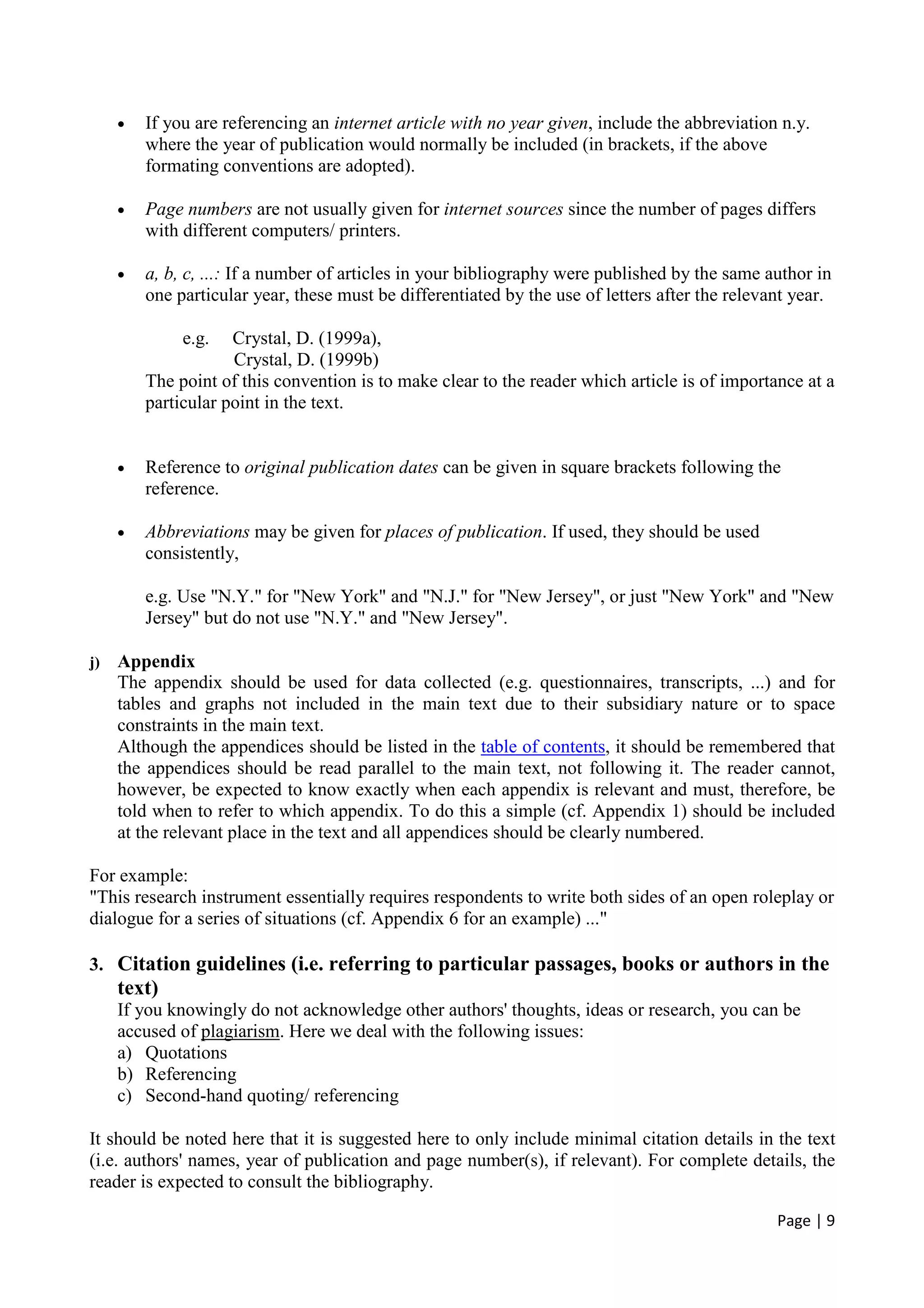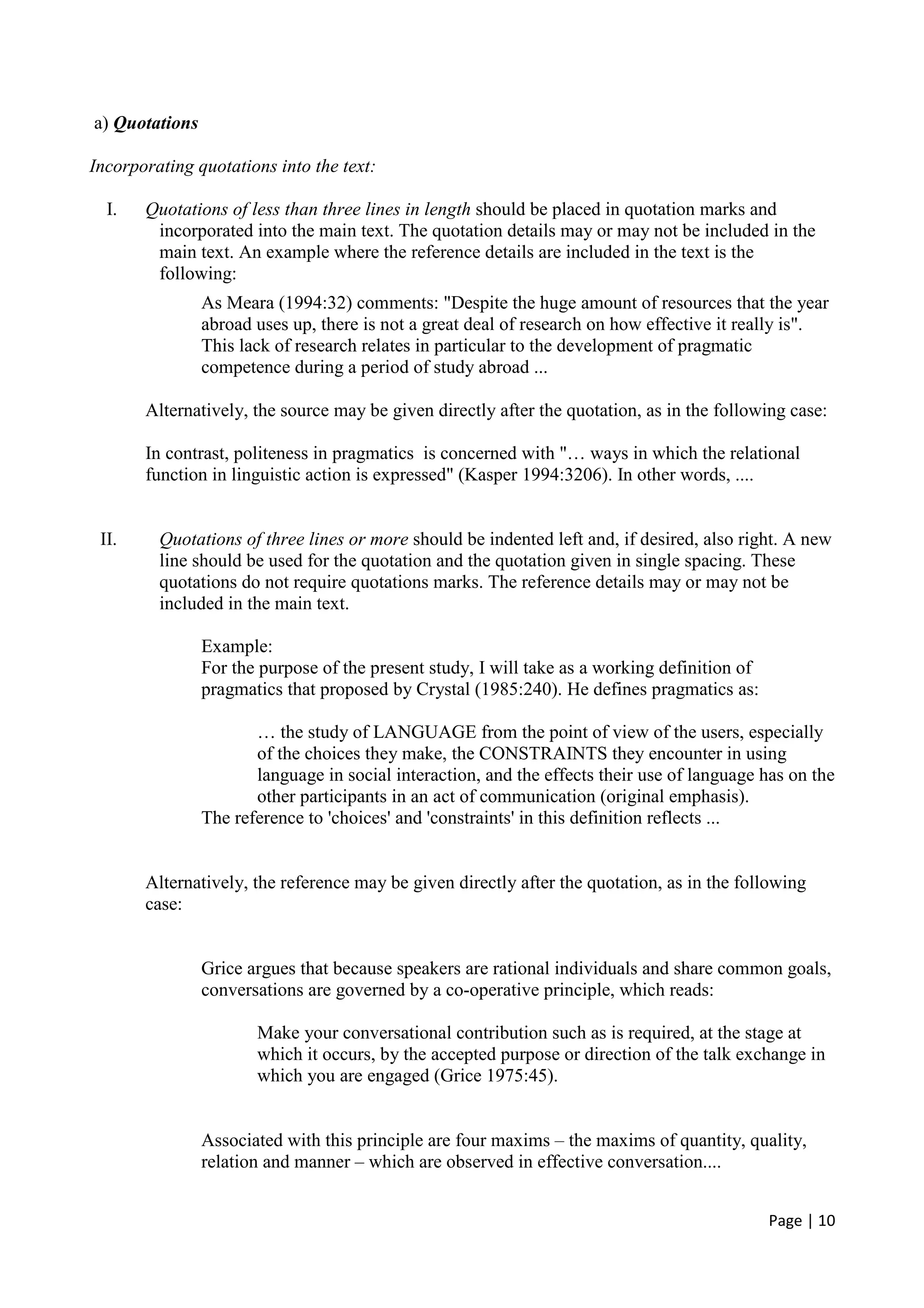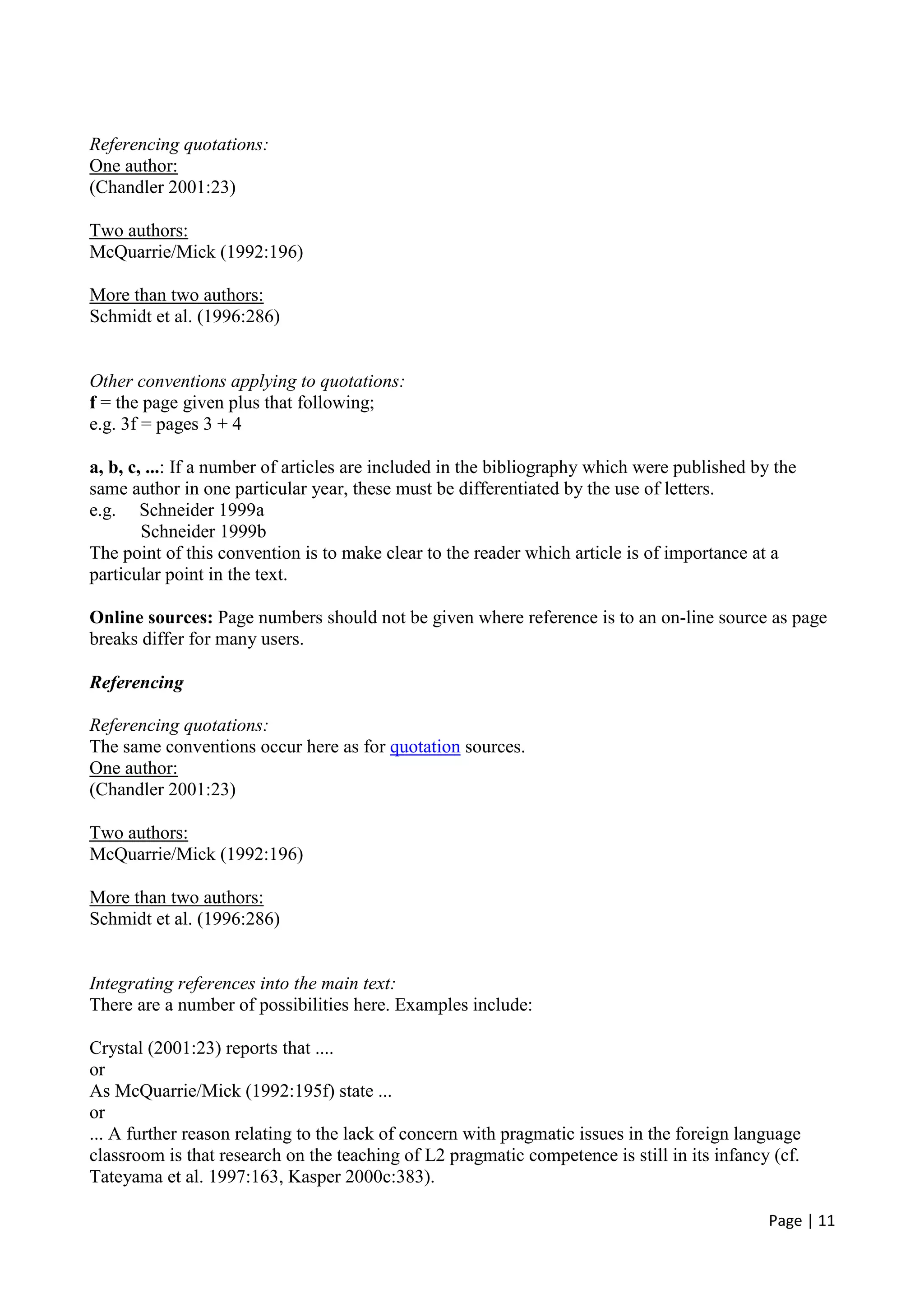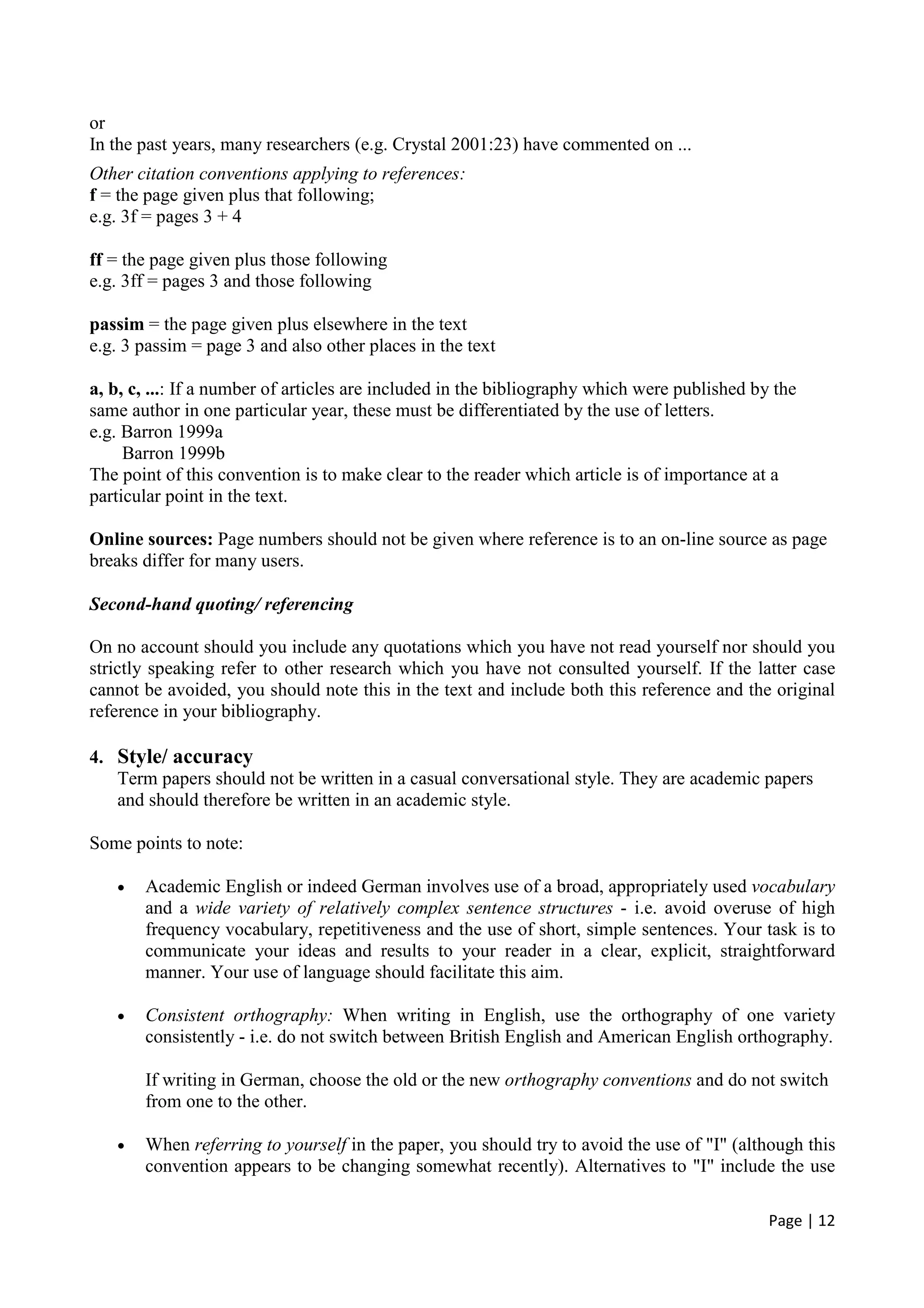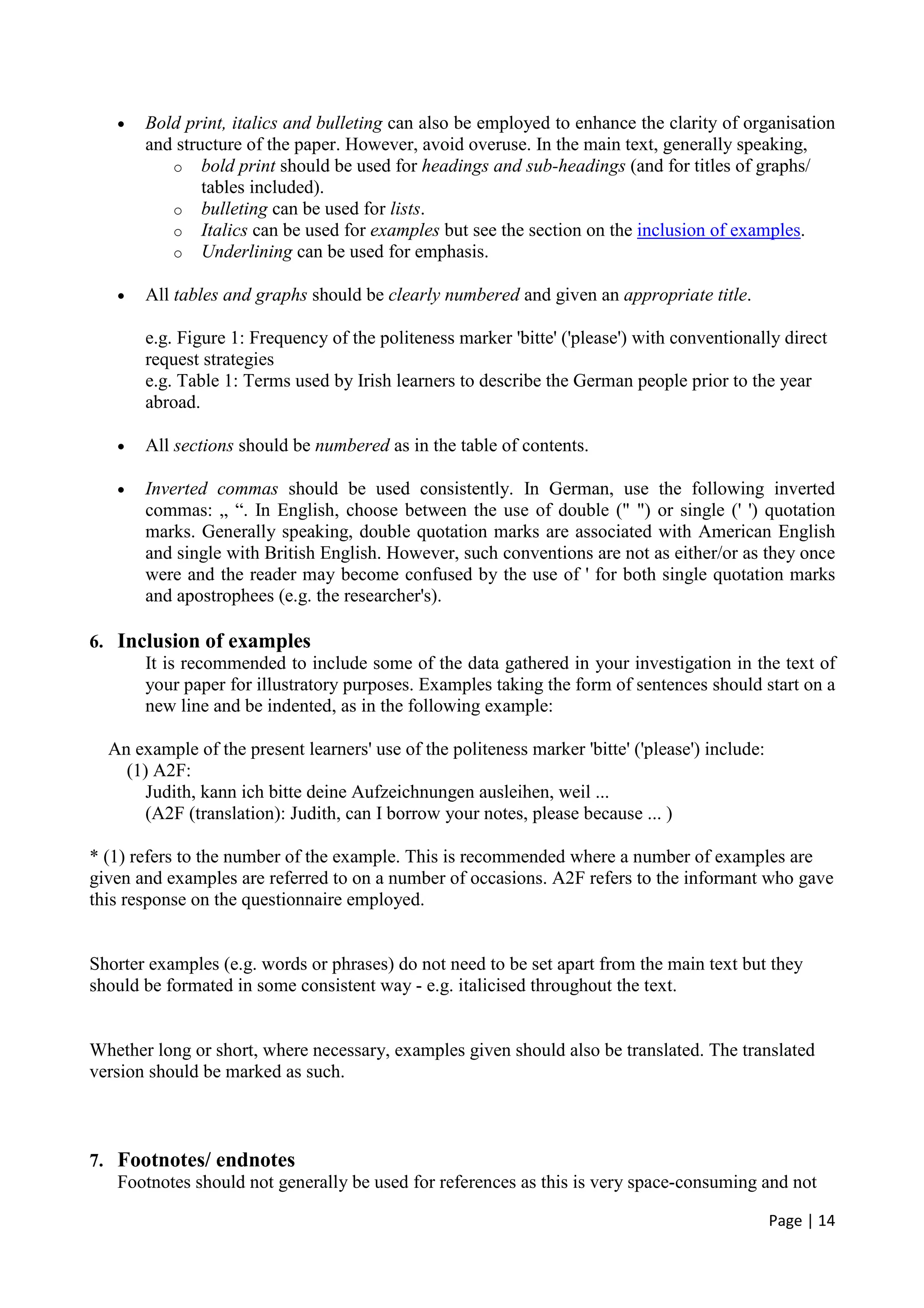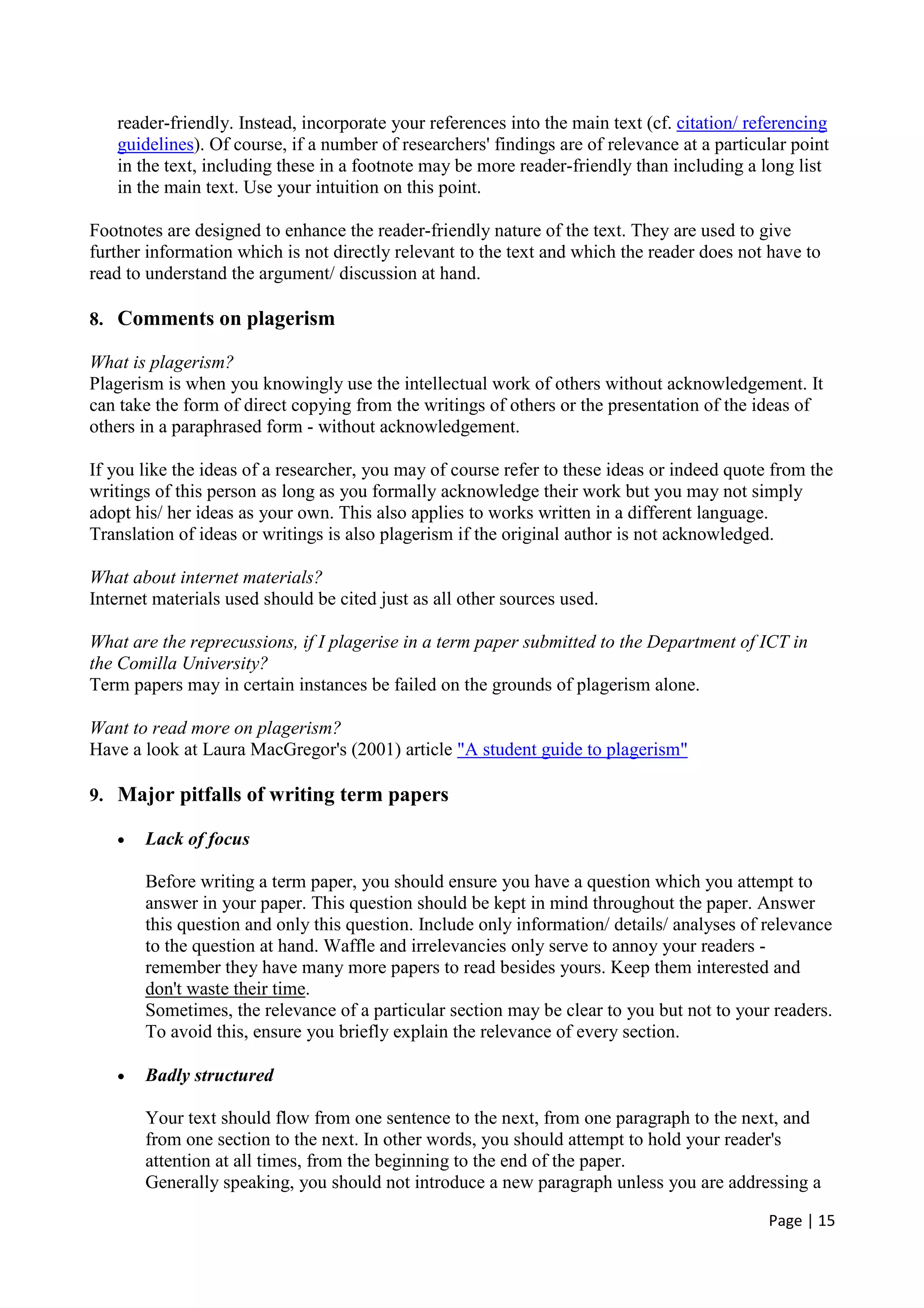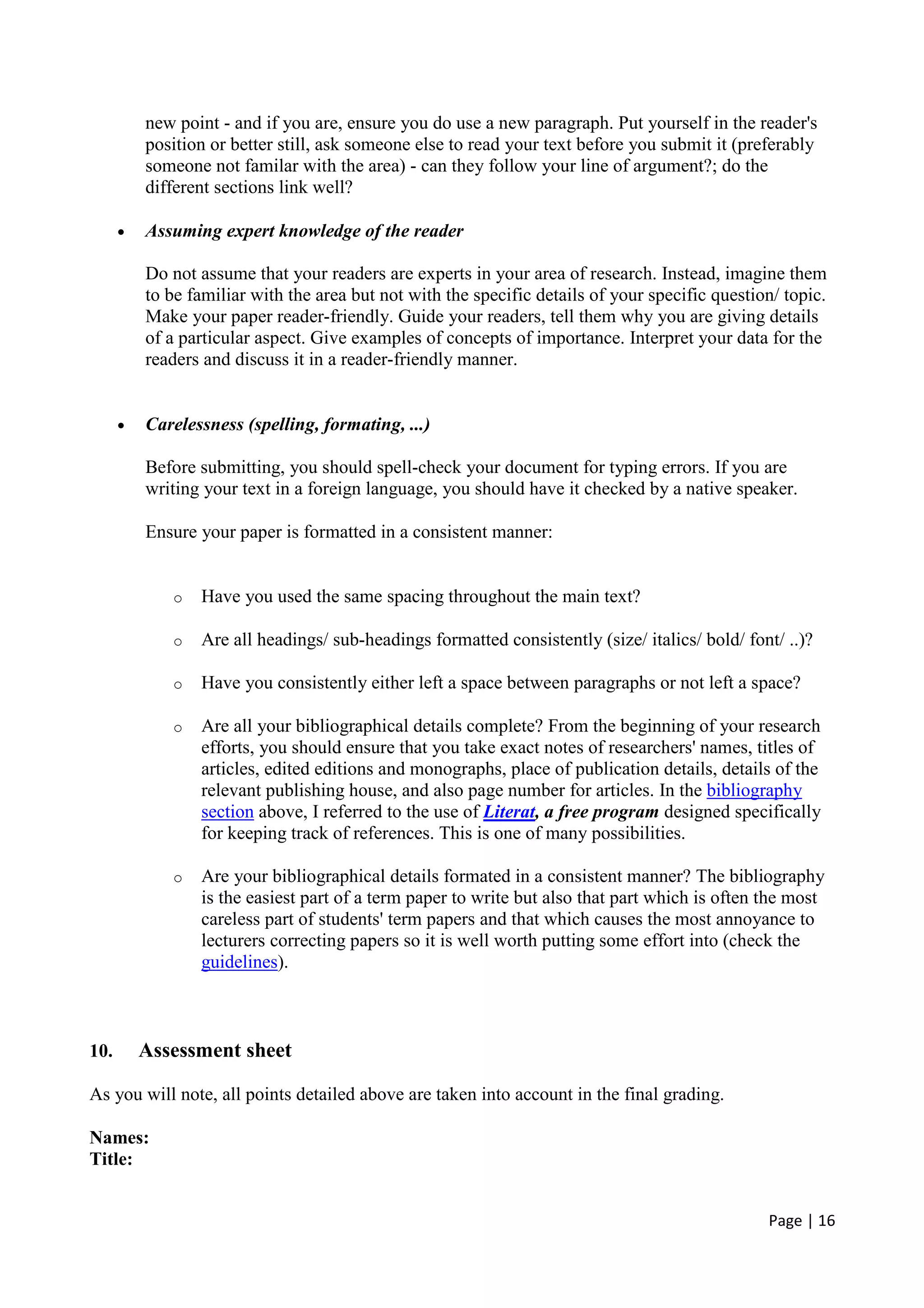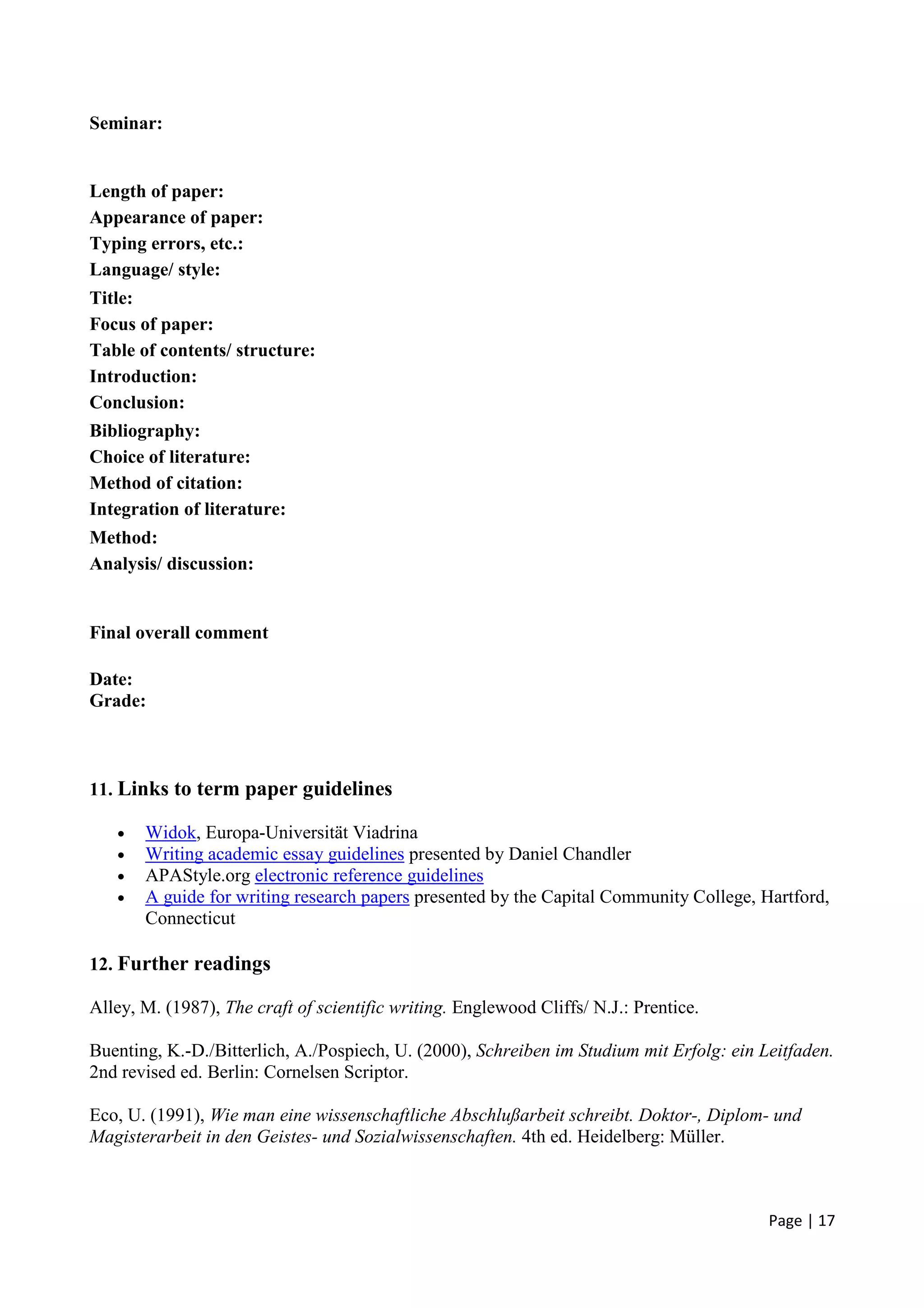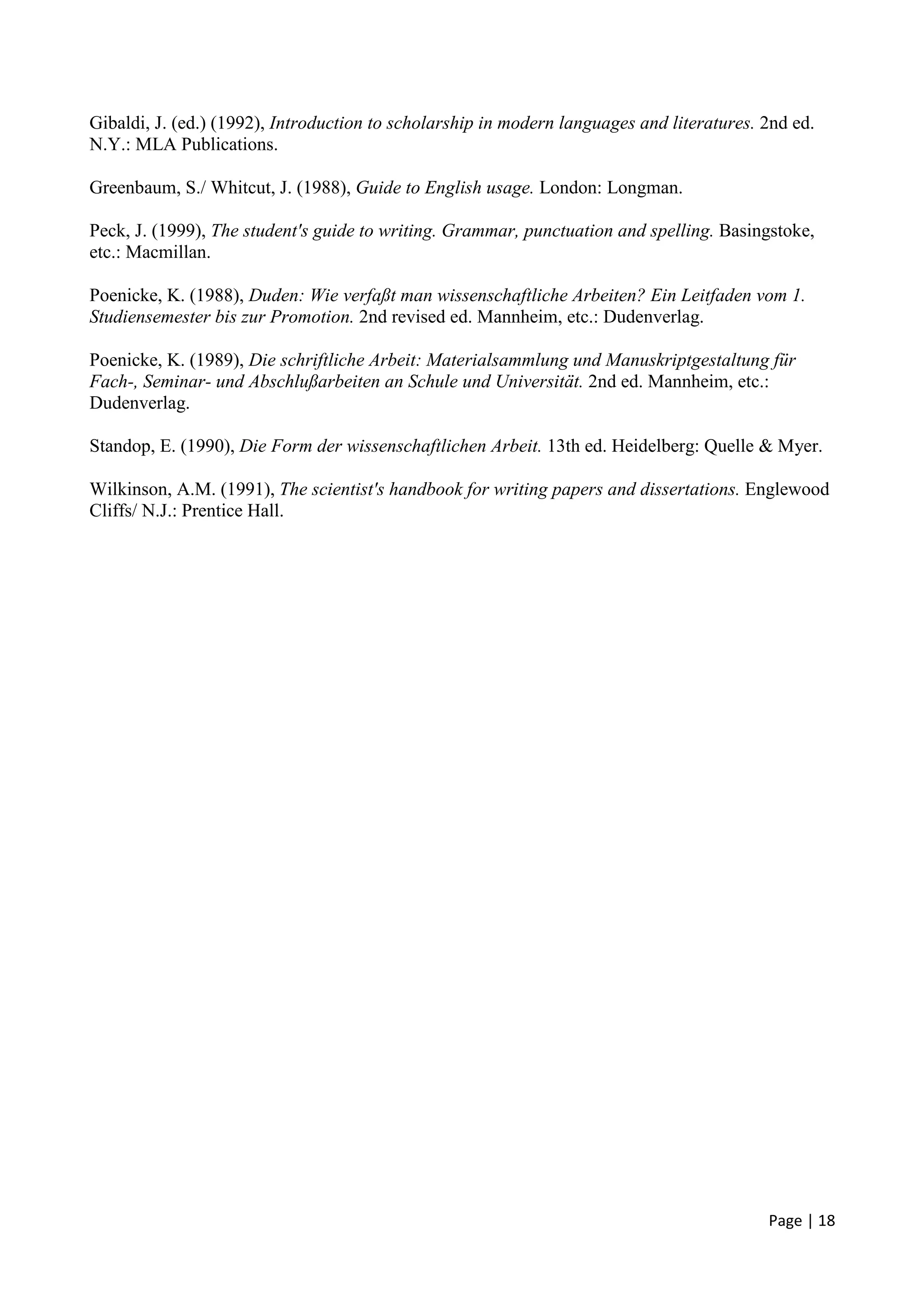The document provides guidelines for writing a term paper, including recommendations for its structure, content, formatting, and citations. Key aspects that must be addressed are length (20-25 pages), structure (introduction, literature review, methodology, etc.), citation style, accuracy, and avoiding plagiarism. Recommendations are provided for each section, including the level of detail required for the methodology, presentation of results, discussion of limitations, and bibliography format. The guidelines aim to help students write a well-structured, scholarly term paper.

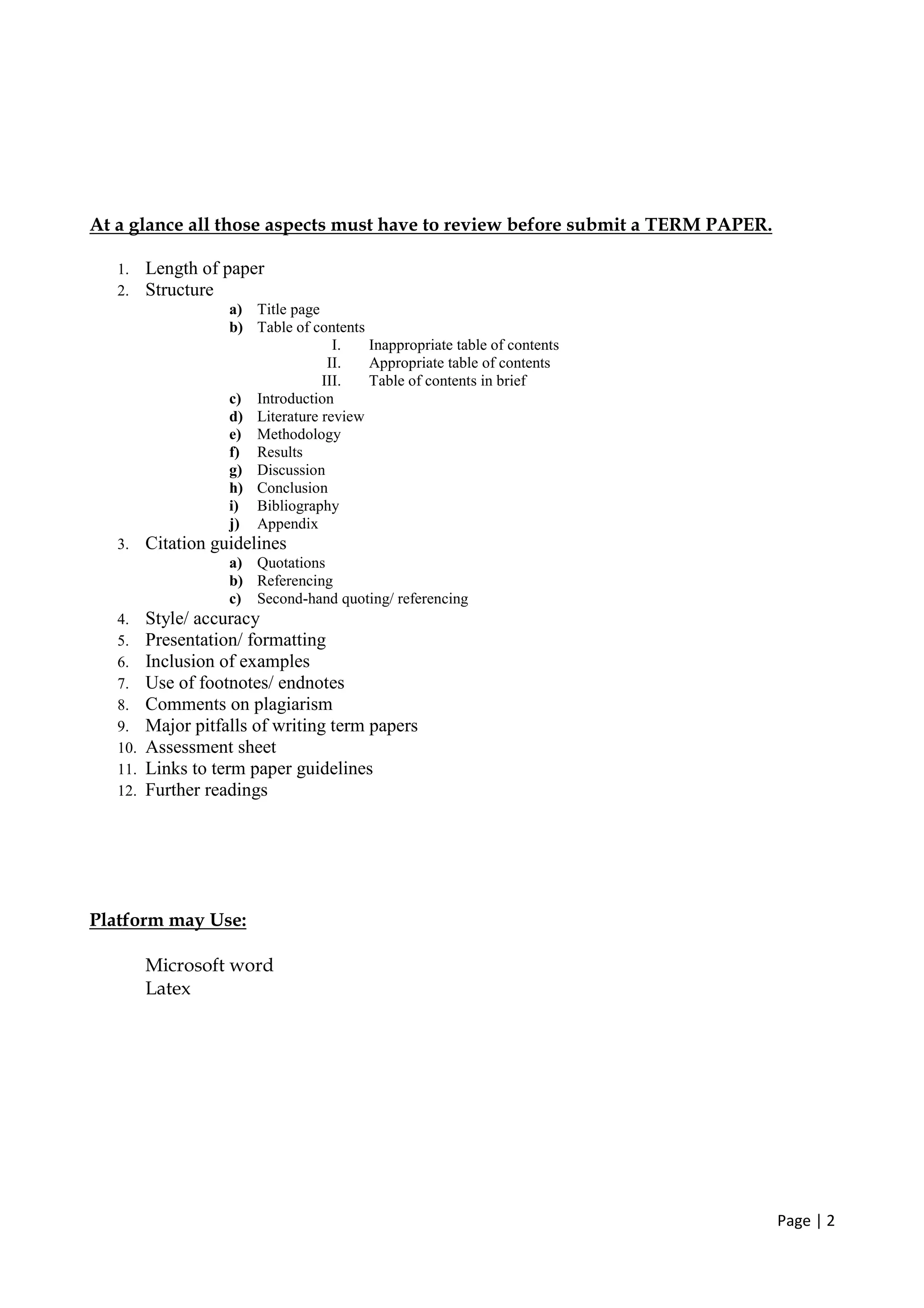
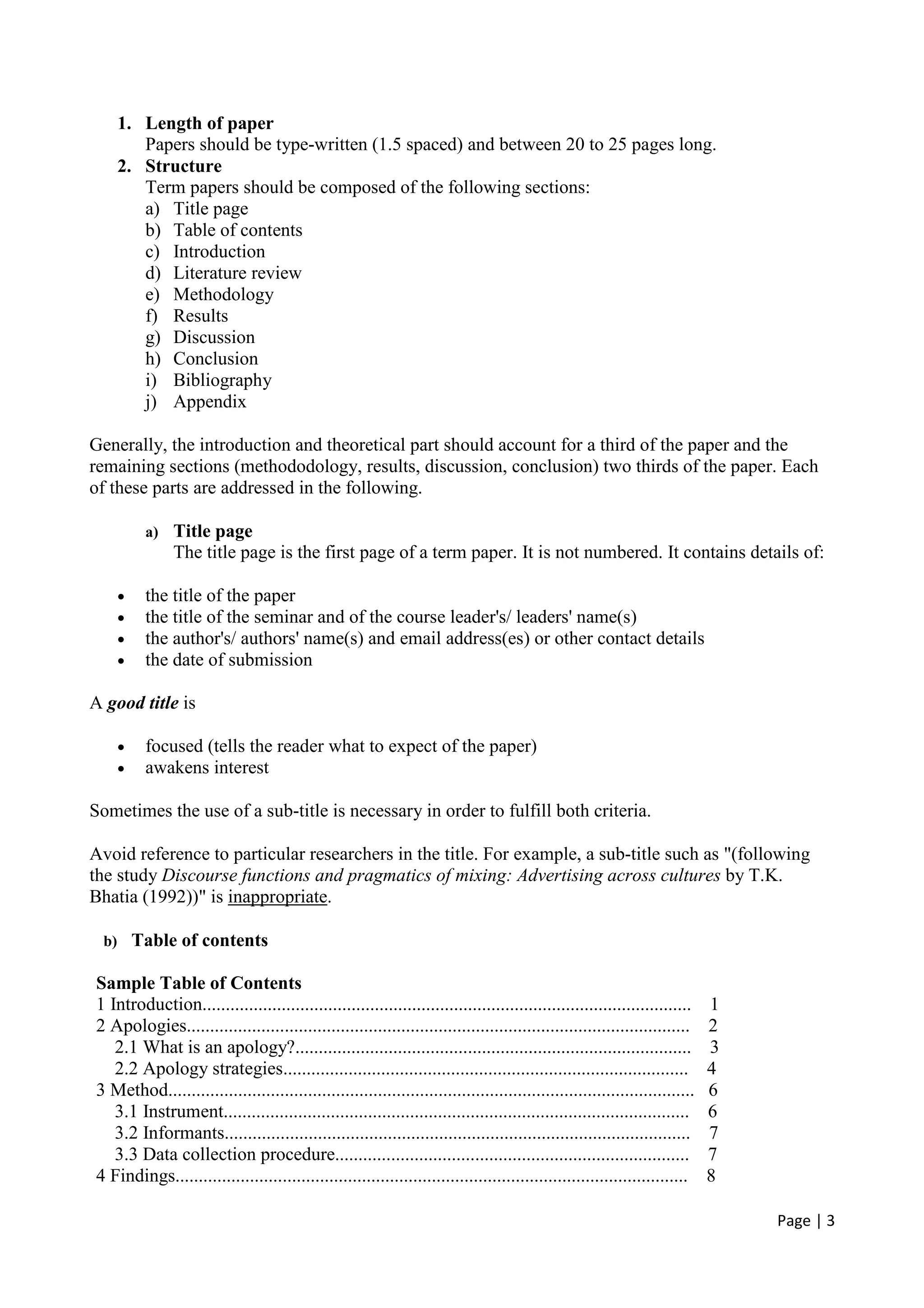
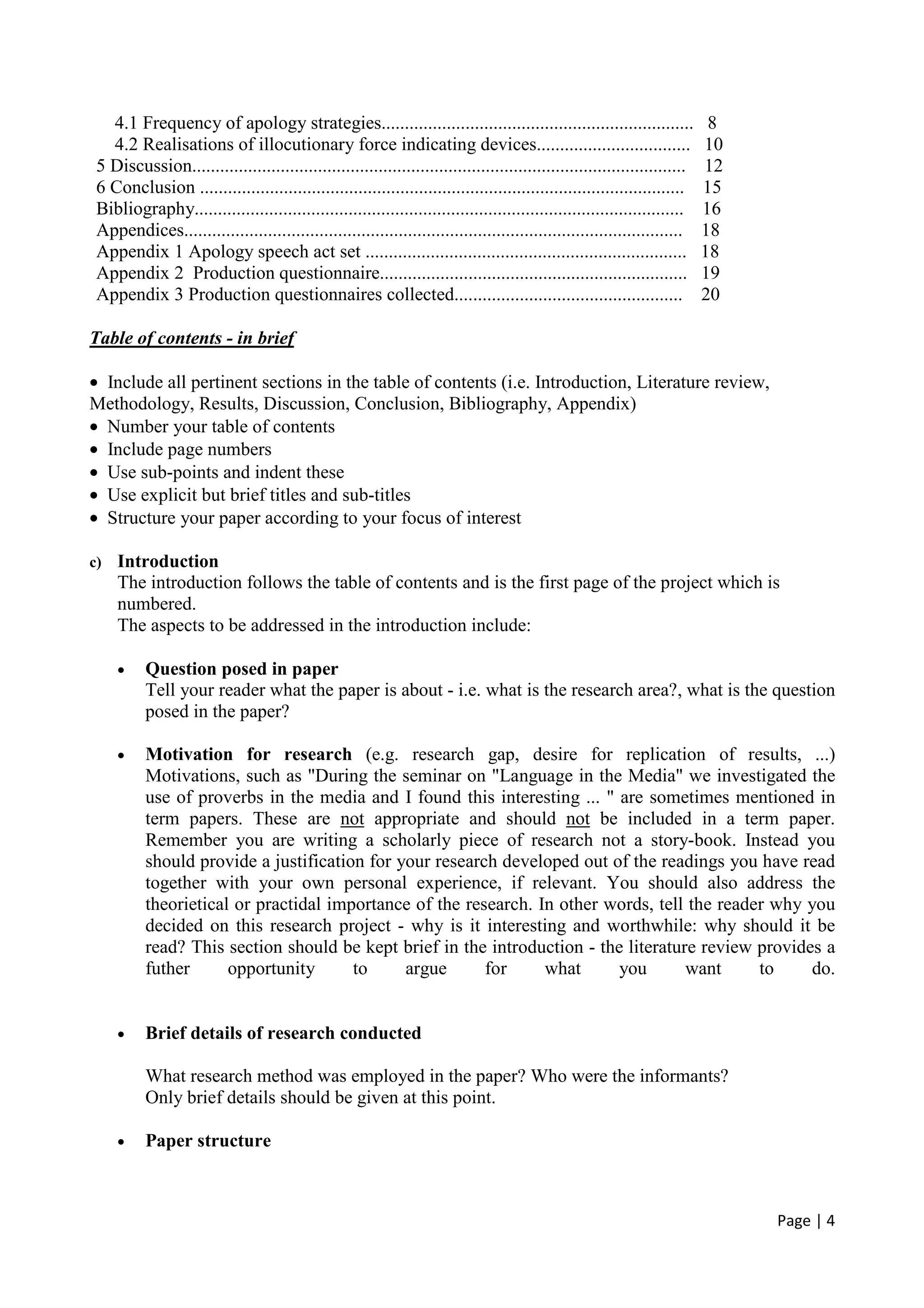
![Page | 5
The point of detailing the structure of the paper is to guide the reader. You know what is
coming next but the reader does not. Tell him/ her what to expect.
d) Literature review
An academic paper should reflect a wide reading of the subject area and a good understanding
of key concepts and findings. The use of examples is one of the best ways of exhibiting your
familiarity with important concepts and it also enhances the reader-friendliness of the paper.
You are expected to be critical in your reading of academic papers. In other words, you should
demonstrate that you are aware of previous research findings(if applicable) but also that you do
not believe everything you read but rather look critically at each study, especially those of
primary interest to your research task. Such a critical awareness may be demonstrated, for
example, by referring to contradictory findings from different researchers, by highlighting the
failings of previous studies (e.g. limited analysis/ less than ideal methodology, etc.) and also by
showing an awareness of questions which remain unanswered.
You should organize your literature review as clearly as possible. Make sure to select only
those studies most directly related to the question at hand. You should not simply provide a
summary of each study but rather tie together the results of the studies so that their relevance is
clear. When conflicting findings are reported in different studies, suggest possible
explanations.
Finally, in line with the introduction, make the case that the research area reviewed is
incomplete or requires extension. This establishes the need for research in the area.
e) Methodology
The method employed in the empirical project conducted should be explicitly detailed. If the
project involves an analysis of a particular corpus, relevant information may include:
• what genre and sub-genre (e.g. advertisements (display/ classified advertisements?; ...),
editorial (service info copy/ opinion copy/ news copy [hard news/ feature article/ special
topic news/ headlines?]) broadcast news (hard news (news bulletins)/ current or public
affairs programs/ special-topic news/ ...?), ...)?
• which media outlets (e.g. publications (newspapers [daily/ weekly?], magazines), TV
channels, radio stations)?
• reason for choice of outlet (e.g. researcher's interest, geographical area, audience type or
size, time of day, quality vs. popular press, interest in production or reception, ...)
• detail on outputs (i.e. what time period was covered?, specific issues or bulletins to be
sampled within this period?)
Alternatively/ additionally, if elicited data forms the empirical basis of your study, relevant details
include those concerning:
• Informants chosen (how many?, average age?, male/ female ratio?, mother tongue?, foreign/
second languages ...? Usually the more homogeneous the informants, the better the research
design).](https://image.slidesharecdn.com/termpaperguideline-130507091640-phpapp01/75/Term-paper-guideline-5-2048.jpg)

![Page | 7
i) Bibliography
From the very beginning of a research project, you should be careful to note all details of
articles gathered. Literat, a free program designed specifically for keeping track of references,
can be downloaded from the philosophical faculty of the University of Düsseldorf. References
filed in this system may be copied easily into MS Word. Alternatively, a simple Word table or a
system of cards may be used. Find the system which is best for you.
The bibliography should contain ALL references included in the paper. References not included in
the text in any form should NOT be included in the bibliography.
The key to a good bibliography is consistency. Choose a particular convention and stick to this. If
you wish to include a full-stop after the date of publication, make sure you do this consistently;
alternatively if you wish to put a comma after the date, do this in all cases.
Bibliographical conventions:
What follows is one possible format which you may use for your bibliography. It follows linguistic
conventions. The researchers' surnames are given first, followed by the initials of the researchers'
first names. After the names follows the year. Titles of edited books, monographs and journals are
given in italics. Details of the publishing house follows those of the place of publication.
Take note of all commas, full-stops and formatting details (e.g. use of italics, etc.)
Monographs
Crystal, D. (2001), Language and the internet. Cambridge: Cambridge University Press.
Edited volumes
Gass, S./Neu, J. (eds.) (1996), Speech acts across cultures. Challenges to communication in a
second language. Berlin/ NY: Mouton de Gruyter.
[(eds.) is used when there is more than one editor; and (ed.) where there is only one editor. In
German the abbreviation used is (Hrsg.) for Herausgeber].
Edited articles
Schmidt, R./Shimura, A./Wang, Z./Jeong, H. (1996), Suggestions to buy: Television commercials
from the U.S., Japan, China, and Korea. In: Gass, S./Neu, J. (eds.) (1996), Speech acts across
cultures. Challenges to communication in a second language. Berlin/ NY: Mouton de Gruyter:
285-316.
* If a number of articles from a particular edited volume are included in the bibliography, there is
no need to list the edited volume each time. Instead the edited volume itself should be listed once
and each reference from the volume in the following short format:
Schmidt, R./Shimura, A./Wang, Z./Jeong, H. (1996), Suggestions to buy: Television commercials
from the U.S., Japan, China, and Korea. In: Gass, S./Neu, J. (eds.) (1996): 285-316.](https://image.slidesharecdn.com/termpaperguideline-130507091640-phpapp01/75/Term-paper-guideline-7-2048.jpg)
![Page | 8
i.e. it is not necessary to give the name of the edited volume, the place of publication or the
publisher each time.
Journal articles:
McQuarrie, E.F./Mick, D.G. (1992), On resonance: A critical pluralistic inquiry into advertising
rhetoric. Journal of consumer research 19, 180-197.
Staczek, J.J. (1993), The English language and the Gulf War: Corpus linguistics, variation, and
word-formation. World Englishes 12, 1, 15-24.
Electronic book:
Chandler, D. (1994), Semiotics for beginners [HTML document]. Retrieved [5.10.'01] from the
World Wide Web, http://www.aber.ac.uk/media/Documents/S4B/.
Electronic journal articles:
Watts, S. (2000) Teaching talk: Should students learn 'real German'? [HTML document]. German
as a Foreign Language Journal [online] 1. Retrieved [12.09.'00] from the World Wide Web,
http://www.gfl-journal.com/.
Other websites:
Verterhus, S.A. (n.y.), Anglicisms in German car advertising. The problem of gender assignment
[HTML document]. Retrieved [13.10.'01] from the World Wide Web,
http://olaf.hiof.no/~sverrev/eng.html.
Unpublished papers:
Takahashi, S./DuFon, M.A. (1989), Cross-linguistic influence in indirectness: The case of English
directives performed by native Japanese speakers. Unpublished paper, Department of English as a
Second Language, University of Hawai'i at Manoa, Honolulu.
Unpublished theses/ dissertations:
Möhl, S. (1996), Alltagssituationen im interkulturellen Vergleich: Realisierung von Kritik und
Ablehnung im Deutschen und Englischen. Unpublished MA thesis, University of Hamburg.
Walsh, R. (1995), Language development and the year abroad: A study of oral grammatical
accuracy amongst adult learners of German as a foreign language. Unpublished PhD dissertation,
University College Dublin.
Also note:
• Remember to follow linguistic rather than literature conventions (i.e. the year of publication
should be placed after researchers' names rather than at the end of the reference).
• The bibliography should be arranged in alphabetical order.](https://image.slidesharecdn.com/termpaperguideline-130507091640-phpapp01/75/Term-paper-guideline-8-2048.jpg)
